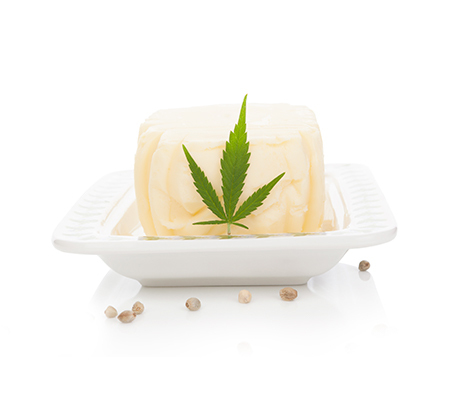
The #1 recipe!
Cannabutter is butter infused with cannabis and is an essential ingredient in the creation of tasty hash treats. It is just one of the numerous ways to enjoy marijuana in food. There are recipes for cannaburgers, cannabis pasta, cannabis cake pops, ganja nachos, and much more. High Times even created an official cookbook with dozens of recipes that involve the use of cannabis.
Rather than provide you with a long list of recipes, this guide will show you how to make cannabutter, cannabis cooking oil, and cannabis-infused coconut oil. We also offer tips on storage and a primer on dosage. We advise you to sit back, learn how to make great cannabutter, and dream of all the fantastic things you can do with it.
How to Make Cannabutter
An increasing number of marijuana users believe that edibles are the best way to consume the herb. When you learn how to make cannabutter, you have the basis for a host of weird and wonderful recipes.
Smoking marijuana is too harsh on the lungs for some people. In contrast, edibles are easy to make or purchase and taste delicious. The strength of cannabis butter depends on the marijuana strain you use and the amount that’s included. Another benefit of creating cannabutter is that you can determine the level of potency.
A major benefit of creating cannabutter is that you can determine the level of potency.
Once the THC from the edible takes effect, you should enjoy a more soothing and relaxing high than when you smoke. Edibles are not the best option for a fast reaction. This is because it can take anywhere from 1–7 hours to take effect, depending on dose, etc. However, the experience will likely feel a lot more intense!
Prospective cannabis cooks must understand the importance of decarboxylation when creating cannabis butter, cannabis oil, or marijuana-infused coconut oil. Also known as ‘decarbing,’ this is the process of unlocking the full potential of your marijuana. Otherwise, you’ll end up consuming raw cannabis, which offers practically no intoxication.
The most efficient way to decarb your weed is by heating it. This process turns THCA into THC by removing the COOH group from the former’s molecule as it releases water and carbon dioxide.
Place your marijuana in an oven at a temperature of at least 240 degrees Fahrenheit (115 degrees Celsius) for between 45 and 60 minutes. Once your weed is decarboxylated, you’re ready to begin making cannabutter.
How to Make Cannabis-Infused Butter (“Cannabutter”)
There are several cannabutter recipes online. All of them can help you create a prime ingredient for your edibles or other weed recipes. Most people are shocked by how easy it is to make cannabutter because the list of ingredients is concise.
If you want to make the best butter, you’ll have to pay decent money for premium-grade marijuana. The decarb process is likely to strip away some THC, so bear this in mind when analyzing the strength of your cannabutter.
Cannabutter Dosage
Making cannabutter is easy; calculating the right dosage is the tricky part. The potency can vary from batch to batch, even if you use the same amount each time. Variables that impact your cannabis butter include the amount of heat applied, individual tolerance, and, of course, the marijuana strains used.
Calculating THC Content
The biggest issue when making cannabutter is determining the THC content of your strain. Potency ranges from 3% in schwag to 30% in the latest batches grown in places like Colorado. Trainwreck’s THC, for example, is anywhere between 12% and 21%.
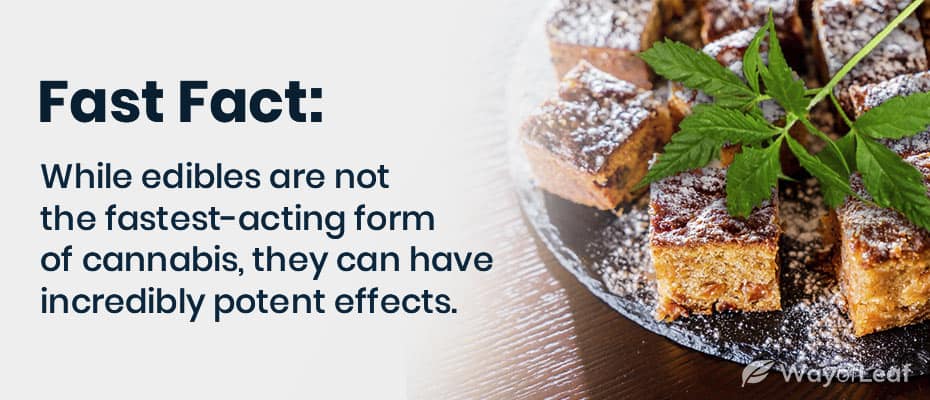
Let’s say it is an average strength version of Trainwreck with a THC content of 15%. The next step involves basic mathematics.
- 1 gram = 1,000 milligrams
- 15% of 1,000 is 150 milligrams
In this instance, one gram of our Trainwreck weed contains 150mg of THC. If you use an ounce (28 grams), it means there is 4,200mg of THC (28 x 150) in your cannabutter.
Now, let’s say you use the entire cup of butter to create a batch of 40 brownies. Each brownie should contain 105mg of THC (4200 / 40 = 105). It is okay to underestimate the THC of the cannabis you purchase slightly.
The decarboxylation process will remove some, no matter what you do. For the record, 105mg of THC is a lot for most people.
Cannabutter Ingredients
Here’s what you’ll need to make cannabis-infused butter:
- 1 cup (approximately 8-11 grams) of decarboxylated ground cannabis. This amount can make 1 – 1.5 cups of butter. You can use up to an ounce if you wish, but take note of the potency
- 5 cups of salted butter
- 1 cup of water
- A container with a lid
- A glass or ceramic bowl that is heat and refrigerator safe
- A pot
- Spatula
- Cheesecloth
- Knife
- Twine
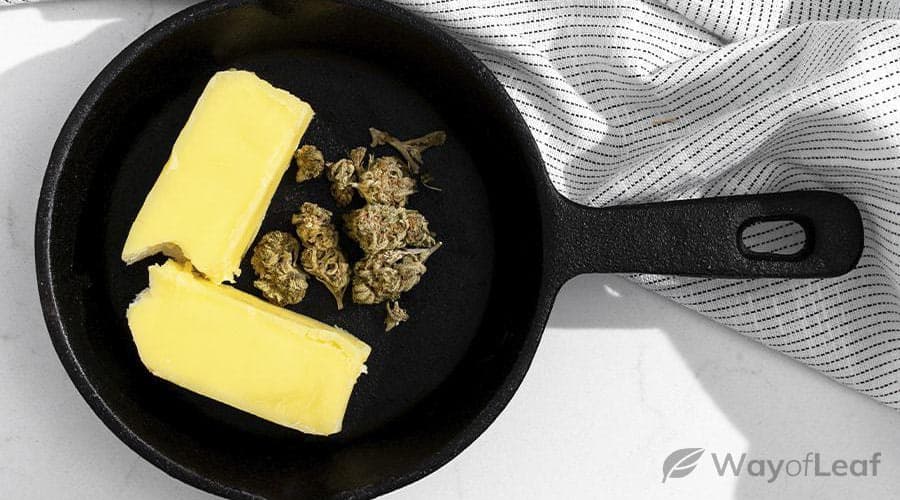
Method
- Add the butter and water to the pot and place it on the stove on the simmer setting. The water helps prevent the butter from burning. Add the marijuana once the butter has melted.
- Keep the mixture on low heat for up to three hours, and make sure you stir occasionally. You must avoid boiling the mix. Remove it from the heat and allow it to cool.
- Use the twine to tie the cheesecloth and create a lid to cover your bowl. Pour the mixture into the bowl. The cloth will act as a filter and remove the plant substance. Alternative strainers include a coffee filter or mesh.
- Take away the cheesecloth, cover your concoction, and put it in the fridge to harden. You will notice that the butter separates from the water. Lift it off with the knife and remove it using a spatula. Place it in an airtight storage container. Dump the remaining water and start dreaming of the cannabis recipes you can use it for.
Cannabis to Butter Ratios
If you aim to enjoy a relaxing high, choose a strain laden with THC. If you wish to use cannabis recipes to help manage symptoms of medical issues, a higher CBD strain is the best option.
Once you have figured out your preferred potency, divide the cannabutter into the correct amounts. When eating edibles made with cannabis butter, follow the ‘go low and slow’ mantra. This means using a small amount of marijuana and waiting at least two hours before having another dose. The effects of edibles start slowly but build up, and ultimately, they will help you get high.
Putting Cannabutter in a Slow Cooker
If you have a slow cooker, you can use it to create cannabutter. It takes a significantly longer time to create than the recipe above. However, it ensures a far more consistent end product. You don’t have to worry as much about having a higher THC concentration in one part of the butter than the rest, for example.
Here are the materials required for a simple cannabutter slow cooker recipe:
- A pound of butter
- A cup of water
- Up to an ounce of marijuana flower; the amount depends on how potent you want the butter
- A storage container
- A cheesecloth or metal strainer
- A slow cooker
Now, here’s how to make it:
- Switch on the slow cooker and place it on the lowest setting.
- Add the ingredients and stir.
- Put the lid on and let the mixture cook for up to 18 hours. A longer cooking time will result in a greater degree of potency.
- Once the cooking time is up, pour your cannabutter through the cheesecloth/metal strainer into a new bowl.
- Store the butter in the fridge. It will harden and separate from the water during the cooling process.
- Remove the cannabutter from the water and place it in an airtight container.
- You have the option of making sous vide cannabutter. However, this requires an immersion circulator. If you do, set your circulator to 185 degrees Fahrenheit and place it in a water bath. Cook your mixture for around four hours with already decarboxylated cannabis, or eight hours if it isn’t yet decarbed.
How Long to Cook Cannabutter in a Crock-Pot?
A lot of people assume that a Crock-Pot and a slow cooker are the same things. However, there are subtle differences. A Crock-Pot is a brand name. It is a stoneware pot surrounded by a heating element. In contrast, a slow cooker is usually a metal pot that you place on top of a heated surface. A ‘slow cooker’ is a type of appliance rather than a brand.
In any case, you can easily make cannabutter in a Crock-Pot, which only has two settings; low and high. There are advanced versions available with digital timers, but you don’t necessarily need one.
The cooking time for cannabutter in a Crock-Pot is the same as when you create the sous vide version. This means four hours with decarbed cannabis and double the time with marijuana you haven’t decarbed.
What Is the Best Way to Make Cannabutter?
One could argue that there is no single best way to make cannabutter. However, we would argue that the step-by-step guides we’ve offered are among the best you’ll find online. You can use a Crock-Pot, slow cooker, or a saucepan.
However, there is also a single-pot method that doesn’t require a strainer. Instead, you need cannabis bud, water, unsalted butter, and water. Make your cannabutter as follows:
- Fill the pot at least halfway up with water and bring it to a boil.
- Add the cannabis and butter, and put the lid on the pot.
- Keep the water boiling for around 90 minutes, but ensure it never boils over.
- Next, turn off the heat and allow the mixture to cool.
- Place it in the fridge for several hours to harden.
- You’ll notice butter floating on top of the pot, making it easy to remove using a spatula.
- The majority of the plant matter will now be at the bottom, though some parts will remain in the butter.
- Divide the butter into several portions and store accordingly!
One other option is to use coconut butter or oil instead of traditional butter. This will provide you with a delicious coconut-flavored product.
Why Use Cannabis Cooking Oil?
Canna-oil is an ideal way for beginners to get into the process of making edibles. Whether you are trying to create a fantastic marijuana butter recipe or learning how to make canna oil, the infusion process is the most challenging part. It is worth persisting with because it potentially offers a stronger effect.
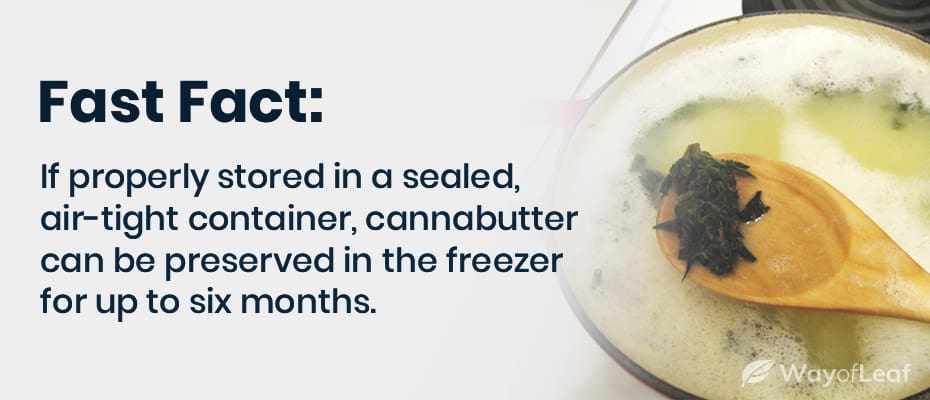
Once you have a handle on calculating THC content, you can determine how much you wish to use in a batch of cannabutter.
One of the reasons it is best to try cannabis butter or marijuana oil is that oils work well with weed. Marijuana’s compounds are fat-soluble. The higher an oil’s fat content, the easier it is for terpenes and cannabinoids such as THC to latch on and become absorbed into your body.
When trying to make THC oil, remember there’s a ‘hierarchy of infused fats’ to consider. MCT oil is at the very top. It extracts the medium-chain triglycerides from coconut oil or palm oil (coconut is better). This type of fat promotes the absorption of the cannabinoids in your weed.
Coconut has almost 80% fat and is one of the best oils to cook with. It can maintain its integrity in high heat better than nearly every other form of fat. Coconut oil is also extremely versatile. You can apply it topically or use it when making THC brownies.
A high-quality extra virgin olive oil is another popular option in canna-oil recipes because it is anti-inflammatory and contains antioxidants. Its main downside is its relatively low heating point, so handle it with care.
How to Make Canna-Oil
All you need is a cup of cannabis flower and a cup of your preferred cooking oil. Other tools required include:
- A double-boiler, slow cooker, or saucepan
- A grinder
- A filter (a cheesecloth is fine)
Here is a simple step-by-step guide:
- Grind your weed using a hand grinder. It is not a good idea to try a coffee grinder because it could obliterate your cannabis. Please note that particles small enough to squeeze through the strainer will end up in the oil.
- Add the weed and oil to the slow cooker or double-boiler and keep the stove on low heat for a few hours. This results in decarboxylation. Six hours is enough when using a slow cooker. If you use a double-boiler, however, you may have to heat it for eight hours.
- Stir occasionally and ensure the maximum heat applied doesn’t exceed 245 degrees Fahrenheit. Add a little water to avoid burning the oil.
- Strain the oil and avoid squeezing your cloth.
- Discard the remaining plant material and store the canna oil in the fridge. It can last for up to two months when stored in this manner.
You could also try to make Rick Simpson Oil, which has become very popular in the MMJ community.
Potential Uses for Cannabutter and Canna-Oil
You can use your marijuana butter or oil to create a wide range of sweet and savory treats, including:
- Muffins
- Pies
- Cakes
- Tarts
Alternatively, add it to:
- Salad dressing
- Soup
- Mashed potatoes
- Pasta
Dosage of Homemade Cannabis Edibles
You must be careful when making cannabutter because its potency is potentially a lot higher than you think. Your homemade brownies are much stronger than a joint. However, as it takes longer to work, you could make the mistake of eating a third or fourth portion. Within a couple of hours, you may have severe couch lock. The reason why cannabutter recipes are so powerful is that your cannabis is turned into an extremely concentrated form during the process.
Cannabutter recipes are so powerful because cannabis is turned into an extremely concentrated form during the process.
It is also true that the edible type makes a significant difference. The muffin you made from cannabis butter is likely to affect you differently from the gummies you purchase online. Please remember that your smoking tolerance is not the same as your edibles tolerance. If you’re used to smoking 30mg of THC, you shouldn’t necessarily have a cannabutter mix that offers 30mg of THC per portion.
Calculations of Dosage May Be Wrong! Use Minimum Dosage
When you make marijuana butter and use it in a recipe, you need to know how much to use for brownies, cakes, etc. There are so many variables that it is practically impossible to get a 100% accurate dose. Even licensed edibles and cannabutter creators find it tricky. They tend to test their weed at various stages.
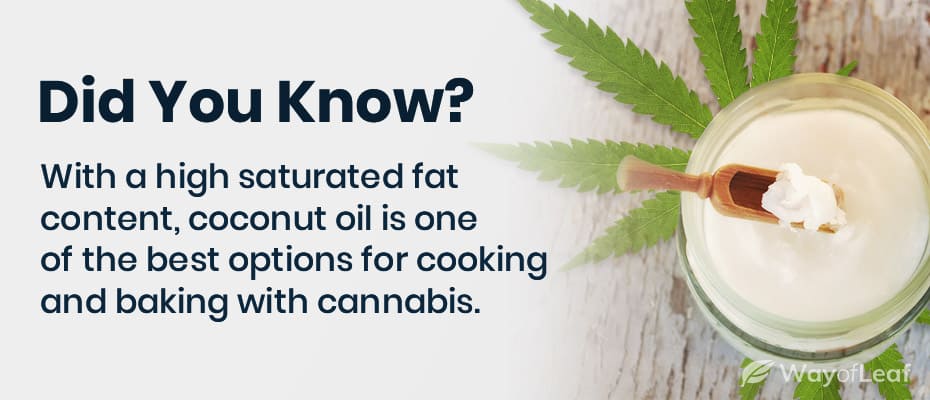
The first test is on the cannabis flowers used in the production run. This gives them an accurate assessment of how many terpenes and cannabinoids are available to extract.
The next test comes after extraction and determines how successful the process was.
Finally, they test again to confirm the level of terpenes and cannabinoids left behind. However, you have none of these facilities to hand when making marijuana butter at home.
To make things even more confusing, the THCA in weed tends to convert into THC at a ratio of 1: 0.88. In other words, you lose 12% of the potential THC straight away. It is also a fact that THC butter and oil extraction are relatively ineffective. Here are some quick tips on dosing:
- Check the label before extraction to see if it tells you the THCA or THC content. If it is the former, multiply by 0.88 to get the possible THC level.
- When making your cannabis butter recipe, portion it vertically. As cannabinoids have different molecular weights, they settle in various places. Do not scoop your cannabutter right off the top because butter from there is entirely different from butter at the bottom.
- Measure everything precisely and cut it into the same-sized portions.
- Always assume that the maximum amount of THC made it into each batch.
Calculating THC Dosage
Calculating the right dosage is not as simple as converting grams to milligrams. Let’s say you have 50 grams of high-quality Bubba Kush, which has a THCA content of 20%. There is a total THCA content of 200 milligrams per gram. Your purchase has a total of 10,000mg of THCA.
When you convert THCA into THC, you multiply by 0.88, so (10000 x 0.88) = 8,800mg of THC in total.
If you use a cannabutter recipe with regular dairy butter, you can expect a maximum efficiency of extraction of 60%. In other words, only (8,800 x 0.6) 5,280mg of THC is extracted.
If you want 100mg of THC per brownie, you will need to make 52-53 brownies in total. Please note that 100mg is the maximum average that each brownie will contain. It could be a lot less depending on various factors.
Possible Effects According to THC Consumption Level
- 1–2.5mg: Improved creativity and focus with mild pain relief. An ideal beginner’s dose.
- 5–15mg: Euphoria and potentially more substantial relief of symptoms. A fair amount for people with insomnia.
- 15–30mg: Potential to impair coordination and could cause powerful euphoria in new users. A dosage for medical marijuana users with an established history of use or people with chronic insomnia.
- 30–50mg: Extremely likely to alter perception. Only for people with a very high tolerance to THC and those with low GI absorption of cannabinoids.
- 50+mg: Possible side effects such as nausea, paranoia, and rapid heart rate. It is a dose that only extremely experienced marijuana users should consider.
Possible Cannabutter Side Effects
If you’re concerned about potential side effects such as paranoia, etc., consider choosing a strain such as Harlequin that has a reasonable amount of CBD. Cannabidiol seemingly counteracts the adverse effects of THC and still offers the same therapeutic potential.
A 1:1 THC – CBD ratio will produce significantly less impairment than a typical marijuana strain. Once you go beyond the 1:4 THC – CBD ratio, you are very unlikely to experience intoxication unless you take a massive dose of THC.
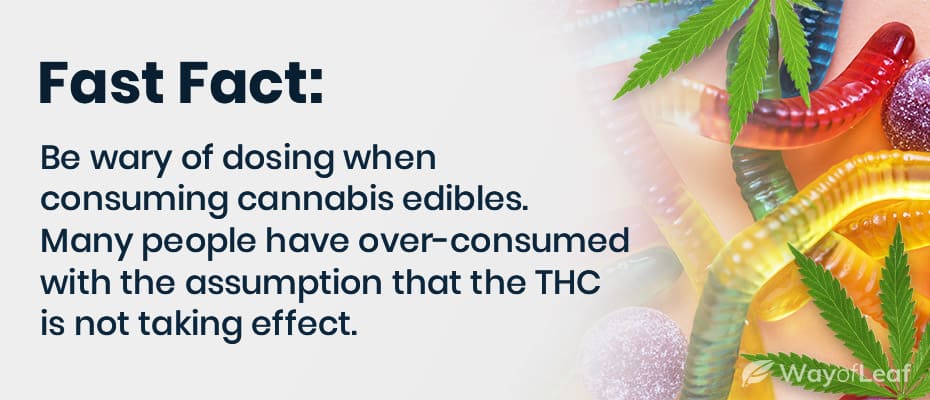
If you consume an edible and don’t feel any effects within an hour, eat a snack to switch on your digestive system’s absorption. You may need two or even three doses in 24 hours before you notice anything.
Trial the dosage with eight-hour intervals until you find an amount that works. Stay hydrated and use the edible in a calm and safe environment. If you begin with the minimum possible dose and work your way up, everything should be fine!
How to Store Cannabis-Infused Products
When it comes to edibles, their perishability varies depending on the ingredients used to make them. Baked goods such as cakes, bread, and brownies expire faster than chocolate or gummies. Sadly, weed brownies can go bad. As for freezing edibles, you can do so and expect them to avoid degrading for several months.
All cannabinoids degrade under prolonged exposure to oxygen, heat, or light. As such, your main concern should be to focus on storage in cool, dark, and sealed locations. When in doubt, store your cannabis-infused chocolate in a sealed container in the fridge.
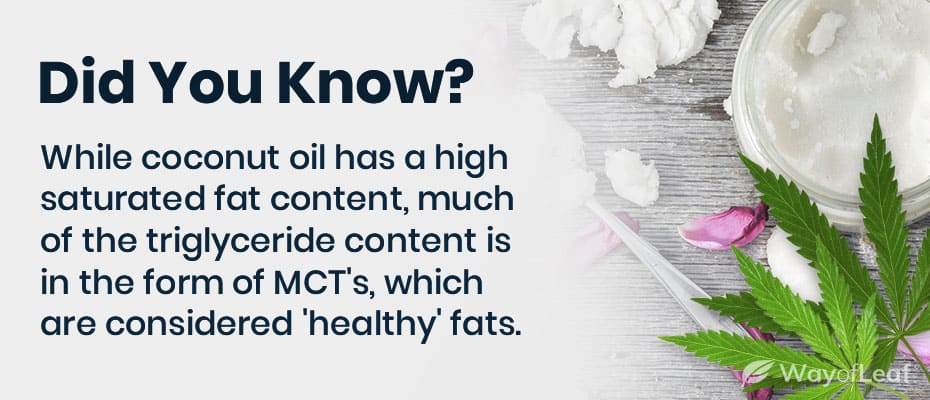
A good rule of thumb is to treat edibles like their non-cannabis counterparts. If your edibles contain dairy, for example, they will go bad after a few days, even in the fridge.
Cookies and brownies last longer but become so hard that you can use them as weapons! As for candies such as lollipops, they are already laden with sugar. As a result, you can keep them for as long as you like in proper storage.
The THC in your edibles shouldn’t degrade to any reasonable degree for months. That is, as long as you follow our tips on proper storage and freeze them if necessary. They won’t taste as good as when they are fresh, but you will still benefit from their effects.
Long-Term Storage of Cannabis-Infused Products
Placing weed-infused products in the refrigerator will expand their life. However, the best place for edibles is the freezer when you plan on keeping them for more than a week or two. Not all edibles benefit from freezing, but it works well for brownies, cannabis oil, and cannabutter.
One excellent tip to prolong infused cooking oils is to pair them with herbs and place them in ice cube trays to freeze. This also works well with marijuana butter.
If you decide to freeze baked goods, we don’t recommend leaving them in ultracold storage for more than a couple of weeks. However, it is an excellent option and much better than having to throw out your favorite pecan chocolate hash brownies.
Final Thoughts on How to Make Cannabutter
We have tried to make this guide as comprehensive as possible and hope it helped you learn all about making cannabutter. The process is even easier than you think, and it enables you to get creative with your cannabis consumption.
However, remember that edibles take longer to work than when you smoke or vape cannabis. Also, their overall effect is more potent, so start slowly and wait patiently for the high to kick in.


![Canna Lemon Drizzle Cake [How-To Make This Infused Dessert]](https://wayofleaf.com/wp-content/uploads/2020/07/wol_canna-lemon-drizzle-cake-how-to-make-this-infused-dessert_1920x450-640x225.jpg)
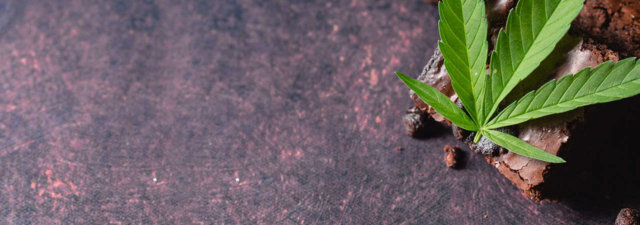
![5 Weed-Infused Hot Chocolate Recipes [YUM]](https://wayofleaf.com/wp-content/uploads/2019/03/mj_cannabis-hot-chocolate-recipes_1920-640x225.jpg)

![CBD Infused Cocktails [Trendy Recipes]](https://wayofleaf.com/wp-content/uploads/2018/10/wol_1920x450-39-640x225.jpg)



![5 Ways to Make Pot Brownies [Best Recipes on the Net]](https://wayofleaf.com/wp-content/uploads/2019/05/mj_ways-to-make-pot-brownies-640x225.jpg)

